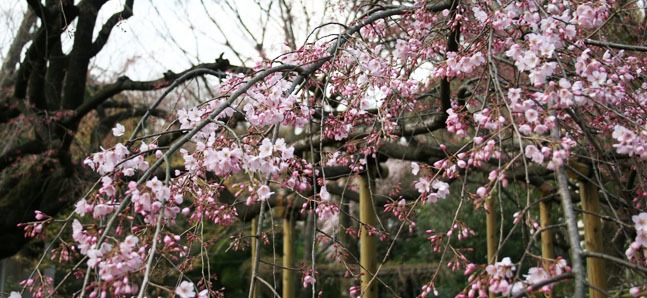
Posted: Wed Apr 07 2010
It's official – on March 23, the Japan Meteorological Agency announced the start of the Tokyo cherry blossom season (hanami), meaning that Tokyo's sakura season is now once again in full swing. According to the record books, which first started in 1953, this year’s blossoms arrived six days earlier than average and one day later than last year.
The agency makes its announcement when there are five to six blossoms on the hyohonboku (sample trees) located on the grounds of Yasukuni Shrine. Each prefecture in Japan has its own hyohonboku; when the buds on the cherry trees (sakura) begin to swell staff from the Bureau of Meteorology begin their daily visits to check on the progress of the blossoms. While some prefectures have ezo-zakura or hikan-zakura varietals as their sample trees, the majority are the somei-yoshino species, the ‘classic’ and ubiquitous species which originated in Someimura, Komagome in Tokyo’s Toshima ward.
The area, known these days as Komagome and Sugamo, was home to many plant nurseries in the Edo period. It was cherry trees from Someimura that spread across Japan as ornamental cherry trees. This spring, be sure to check out the many famous cherry tree spots in the Komagome area, such as Rokugien and Asukayama Park. Keep in mind, though, that it’s not all about the blossoms. We’ve put together some of the other Komagome highlights that will make your cherry blossom viewing experience all the more enjoyable, before and after you lay your eyes on some sakura.
Shopping Streets (shotengai)

In the Komagome area there are over ten shopping streets including the 400 metre-long Somei Ginza shotengai, and Shimofuri shotengai, which has been growing since 1940. While each of the shopping streets are a hive of activity, there are plenty of interesting places to find if you take a wander from Shimofuri shopping street to Somei Ginza shopping street. First, we recommend stopping in for a bite at one of the places below – located at the entrance to the Shimofuri shotengai – before heading on for a leisurely bit of shopping. For those with a sweet tooth try Masayume, while those looking for something more savoury should try Yakitori Buta-ya de Tori-ya.
Masayume (Full details & map)
Yakitori Buta-ya De Tori-ya (Full details & map)
K
This place is usually a full house at lunchtime. With a husband-wife team behind the counter, the inside is on the small side and consists of a counter with seats for five, and two tables for four people. What K lacks in size, it makes up for in other ways: the food comes in sure-to-satisfy portions, and the prices are a steal, making it a great place to get a good, honest feed. On the menu are favourites like Japanese style hamburger patties (hambagu), sautéed pork, deep fried prawns and shogayaki (sautéed ginger pork), served with a mountain of shredded cabbage, pickles and miso soup on the side. Hand over a ¥1000 note and you’ll be getting back some change.
(Full details & map)
Kagaya Komagome
Fill your stomach and grab a couple of drinks at this homey izakaya (Japanese-style pub). At Kagaya, motsu yaki (grilled giblets) and nimono boiled dishes are the standard favourites, but we especially recommend the atsuage (deep fried tofu). The tofu is fried-to-order, coming to your table piping hot, with a generous serving of scallions and grated ginger for ¥380. Also on the menu is a range of kushiage (deep fried skewers) which start at ¥200 per stick. Try the meat kushiage and you’ll be surprised at the size of the portions of meat. The shochu sours come with the shochu in a glass and the sour mix in a bottle, allowing you to adjust the strength to your liking. For your second drink,ask for your 'shochu nakami' (in the glass) and 'sour sotomi' (on the side) and you'll be joining the ranks of regular customers.
(Full details & map)
Denjo Yu
After a good wander around Komagome, choose from the many sento (public baths) to finish with a good soak. We give a special thumbs-up to Denjo Yu. This public bath has been in the same family for over 50 years, and is currently being run by the fifth head of the family. On the wall inside the bathhouse is Denjo Yu’s showpiece, a picture of view of Mt. Fuji from West Izu. The bath is spacious and has a shallow section, which is perfect for lying back and relaxing. Another point of interest is that Denjo Yu has an on-site well from which they draw their high quality water. Sento-goers can get a taste of the water from a dispenser located in front of the booth at the entrance. The bathhouse also sells its own brand of water called ‘vivestar biz’. The well-water is usually ¥1,400 for 12 litres (3 gallons) and ¥2,100 for 18.5 litres (5 gallons). Denjo Yu is currently running a promotion whereby customers can receive water for free. Place your order after taking a look at the fliers located inside the bathhouse and you will receive 2 bottles which hold 12 litres each and free use of the water dispenser to fill them.
(Full details & map)
Related articles:
・All aboard for hanami
Glimpse of Tokyo’s best cherry blossoms from the rails
・Tokyo’s cherry blossom lanes
In Tokyo, you’re never far away from a street lined with cherry trees
・Sakura-mochi now blooming
Delectable bite-sized treats to bring in the spring
Tweets
- About Us |
- Work for Time Out |
- Send us info |
- Advertising |
- Mobile edition |
- Terms & Conditions |
- Privacy policy |
- Contact Us
Copyright © 2014 Time Out Tokyo










Add your comment